University Report: Organizational Development Change, Models and Roles
VerifiedAdded on 2022/10/13
|14
|3092
|15
Report
AI Summary
This report delves into the intricacies of organizational development and change management. It begins by exploring various models, including Lewin's three-step model, Ulrich's seven-step model, Weick and Quinn's three-step model, and Kotter's eight-step model, analyzing their applications and effectiveness in managing organizational transformations. The report then identifies and examines the roles of key players in the change process, such as the management team, leaders, agents, active participators, and consultants, highlighting their responsibilities and contributions to successful implementation. Finally, it provides a set of recommendations aimed at improving communication, addressing employee emotions, enhancing working skills, fostering a constructive working approach, energizing participators, and incorporating changes as a catalyst for growth. The report emphasizes the importance of adapting management strategies to the unique characteristics of each organization and its workforce to achieve optimal outcomes.
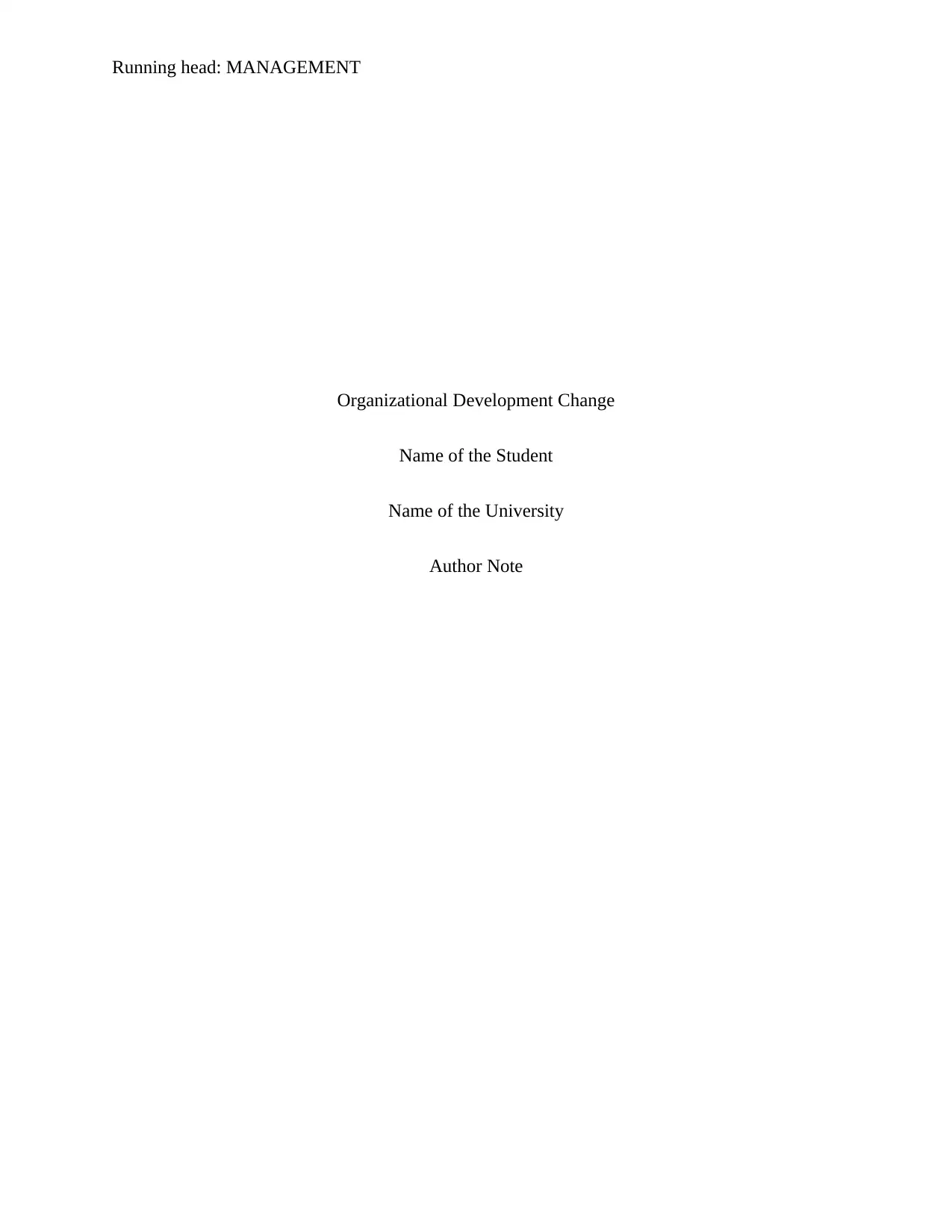
Running head: MANAGEMENT
Organizational Development Change
Name of the Student
Name of the University
Author Note
Organizational Development Change
Name of the Student
Name of the University
Author Note
Paraphrase This Document
Need a fresh take? Get an instant paraphrase of this document with our AI Paraphraser
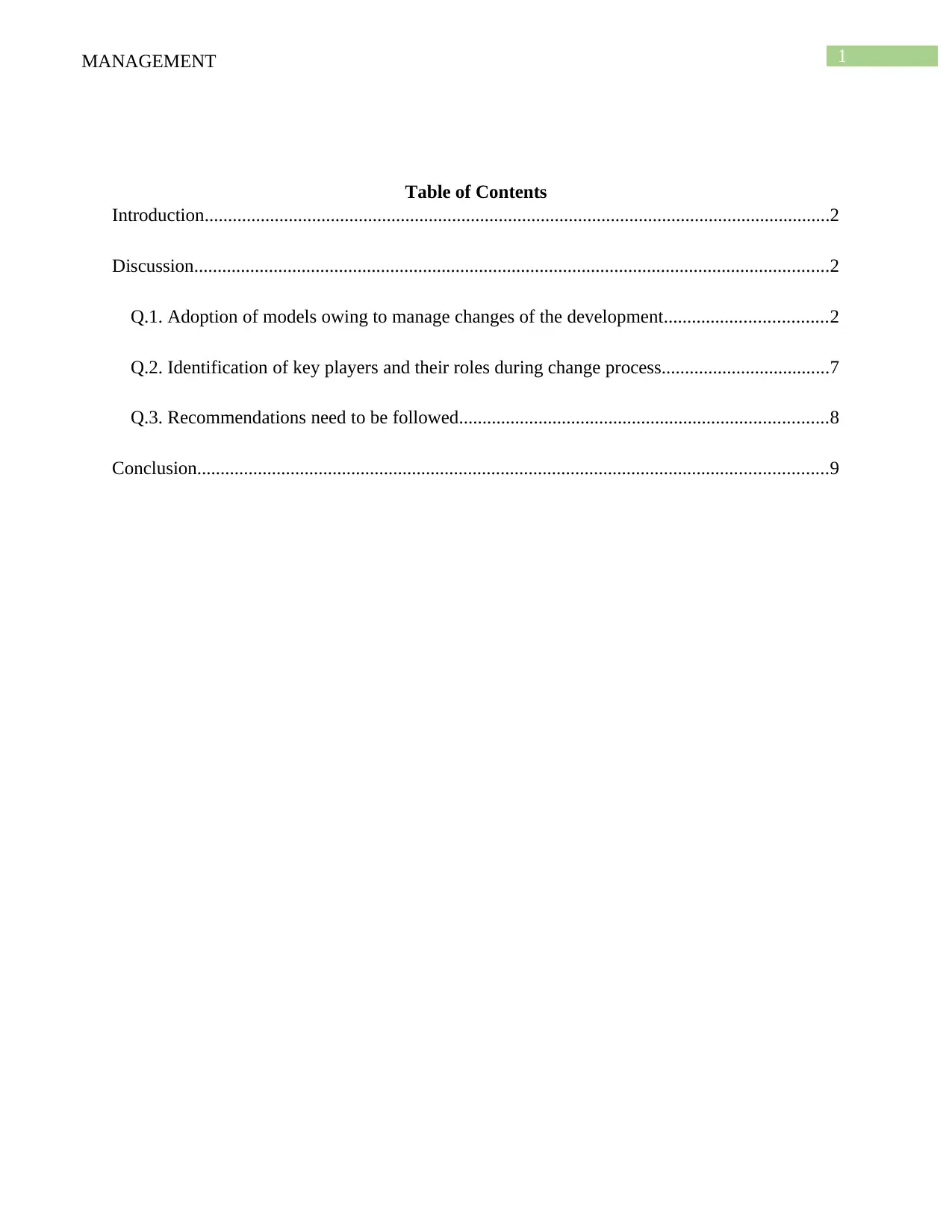
1MANAGEMENT
Table of Contents
Introduction......................................................................................................................................2
Discussion........................................................................................................................................2
Q.1. Adoption of models owing to manage changes of the development...................................2
Q.2. Identification of key players and their roles during change process....................................7
Q.3. Recommendations need to be followed...............................................................................8
Conclusion.......................................................................................................................................9
Table of Contents
Introduction......................................................................................................................................2
Discussion........................................................................................................................................2
Q.1. Adoption of models owing to manage changes of the development...................................2
Q.2. Identification of key players and their roles during change process....................................7
Q.3. Recommendations need to be followed...............................................................................8
Conclusion.......................................................................................................................................9
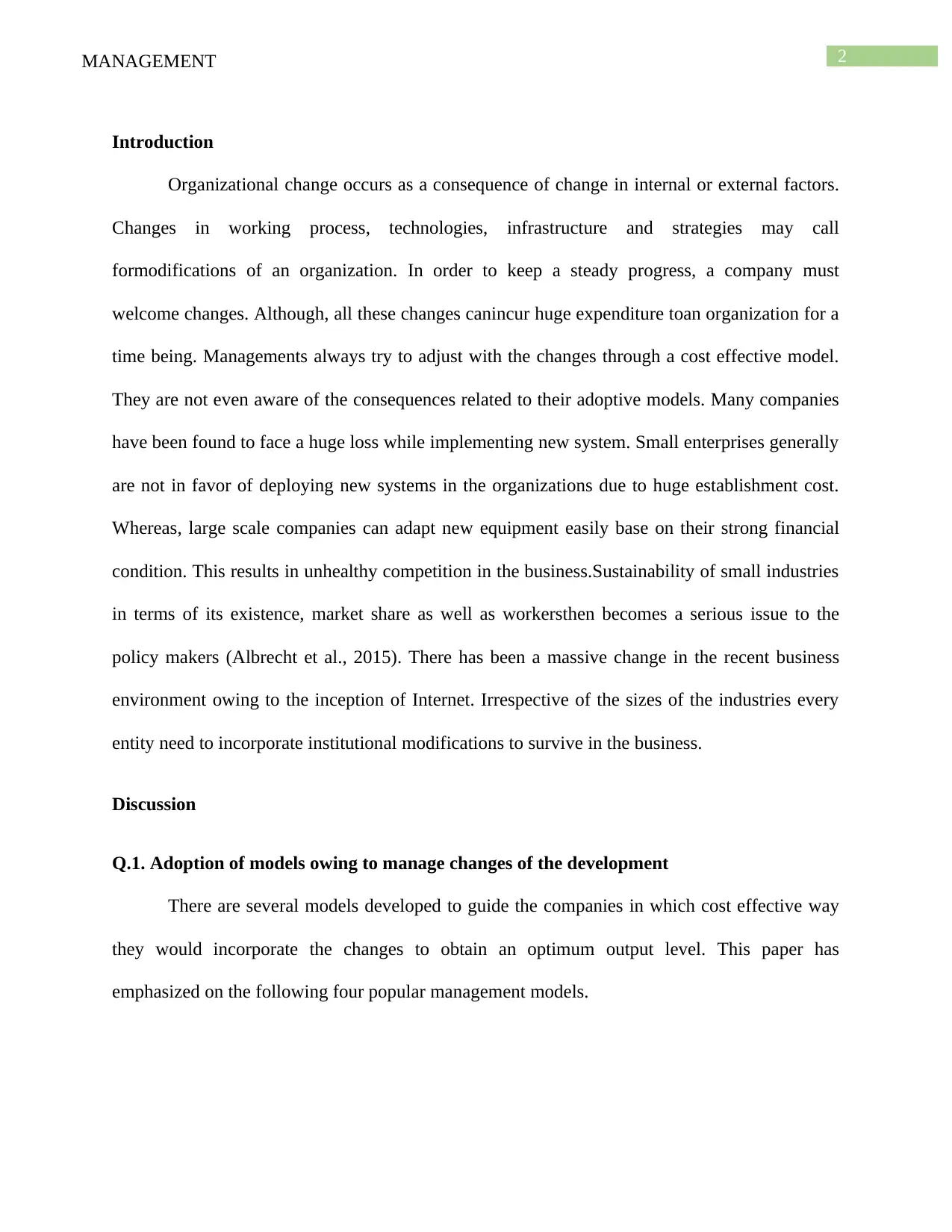
2MANAGEMENT
Introduction
Organizational change occurs as a consequence of change in internal or external factors.
Changes in working process, technologies, infrastructure and strategies may call
formodifications of an organization. In order to keep a steady progress, a company must
welcome changes. Although, all these changes canincur huge expenditure toan organization for a
time being. Managements always try to adjust with the changes through a cost effective model.
They are not even aware of the consequences related to their adoptive models. Many companies
have been found to face a huge loss while implementing new system. Small enterprises generally
are not in favor of deploying new systems in the organizations due to huge establishment cost.
Whereas, large scale companies can adapt new equipment easily base on their strong financial
condition. This results in unhealthy competition in the business.Sustainability of small industries
in terms of its existence, market share as well as workersthen becomes a serious issue to the
policy makers (Albrecht et al., 2015). There has been a massive change in the recent business
environment owing to the inception of Internet. Irrespective of the sizes of the industries every
entity need to incorporate institutional modifications to survive in the business.
Discussion
Q.1. Adoption of models owing to manage changes of the development
There are several models developed to guide the companies in which cost effective way
they would incorporate the changes to obtain an optimum output level. This paper has
emphasized on the following four popular management models.
Introduction
Organizational change occurs as a consequence of change in internal or external factors.
Changes in working process, technologies, infrastructure and strategies may call
formodifications of an organization. In order to keep a steady progress, a company must
welcome changes. Although, all these changes canincur huge expenditure toan organization for a
time being. Managements always try to adjust with the changes through a cost effective model.
They are not even aware of the consequences related to their adoptive models. Many companies
have been found to face a huge loss while implementing new system. Small enterprises generally
are not in favor of deploying new systems in the organizations due to huge establishment cost.
Whereas, large scale companies can adapt new equipment easily base on their strong financial
condition. This results in unhealthy competition in the business.Sustainability of small industries
in terms of its existence, market share as well as workersthen becomes a serious issue to the
policy makers (Albrecht et al., 2015). There has been a massive change in the recent business
environment owing to the inception of Internet. Irrespective of the sizes of the industries every
entity need to incorporate institutional modifications to survive in the business.
Discussion
Q.1. Adoption of models owing to manage changes of the development
There are several models developed to guide the companies in which cost effective way
they would incorporate the changes to obtain an optimum output level. This paper has
emphasized on the following four popular management models.
⊘ This is a preview!⊘
Do you want full access?
Subscribe today to unlock all pages.

Trusted by 1+ million students worldwide
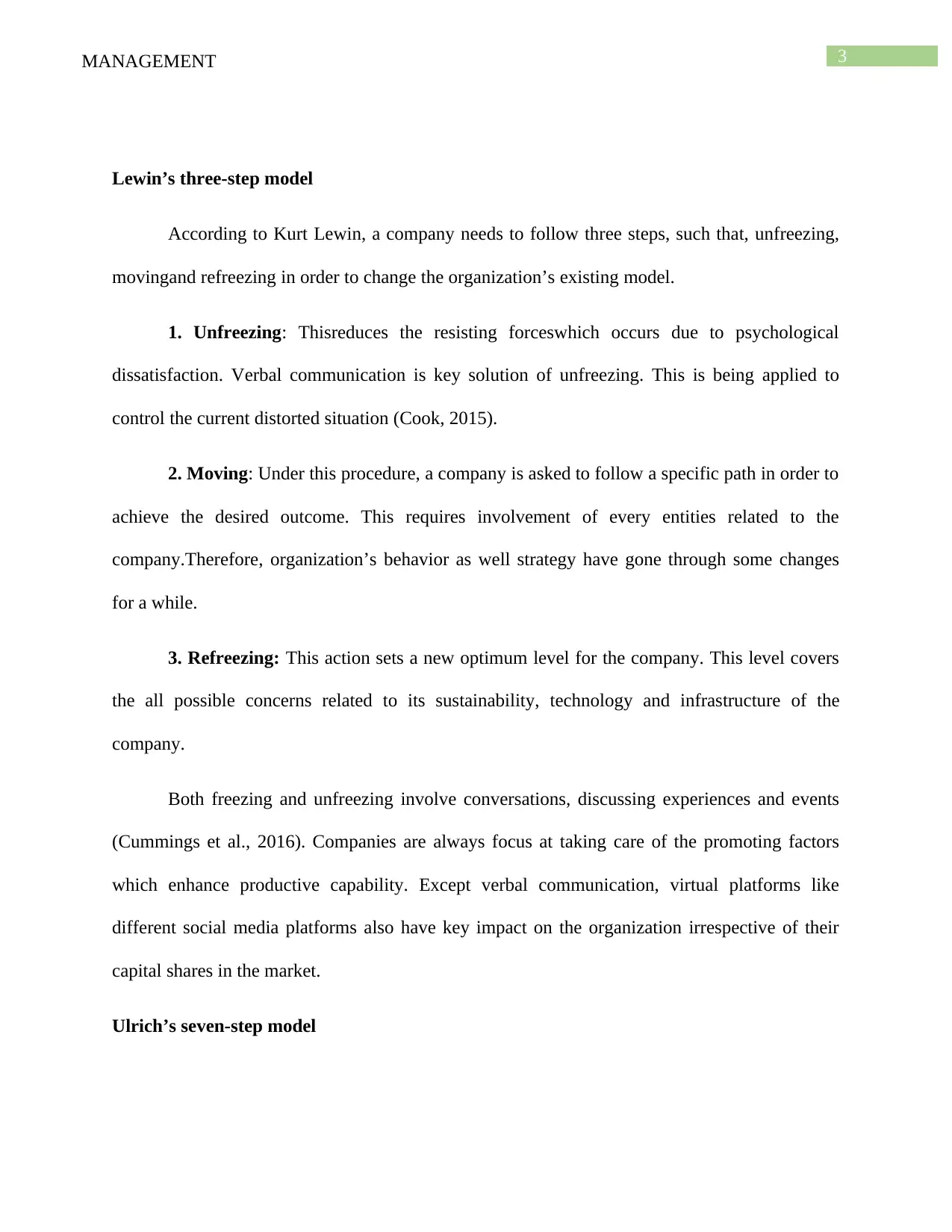
3MANAGEMENT
Lewin’s three-step model
According to Kurt Lewin, a company needs to follow three steps, such that, unfreezing,
movingand refreezing in order to change the organization’s existing model.
1. Unfreezing: Thisreduces the resisting forceswhich occurs due to psychological
dissatisfaction. Verbal communication is key solution of unfreezing. This is being applied to
control the current distorted situation (Cook, 2015).
2. Moving: Under this procedure, a company is asked to follow a specific path in order to
achieve the desired outcome. This requires involvement of every entities related to the
company.Therefore, organization’s behavior as well strategy have gone through some changes
for a while.
3. Refreezing: This action sets a new optimum level for the company. This level covers
the all possible concerns related to its sustainability, technology and infrastructure of the
company.
Both freezing and unfreezing involve conversations, discussing experiences and events
(Cummings et al., 2016). Companies are always focus at taking care of the promoting factors
which enhance productive capability. Except verbal communication, virtual platforms like
different social media platforms also have key impact on the organization irrespective of their
capital shares in the market.
Ulrich’s seven-step model
Lewin’s three-step model
According to Kurt Lewin, a company needs to follow three steps, such that, unfreezing,
movingand refreezing in order to change the organization’s existing model.
1. Unfreezing: Thisreduces the resisting forceswhich occurs due to psychological
dissatisfaction. Verbal communication is key solution of unfreezing. This is being applied to
control the current distorted situation (Cook, 2015).
2. Moving: Under this procedure, a company is asked to follow a specific path in order to
achieve the desired outcome. This requires involvement of every entities related to the
company.Therefore, organization’s behavior as well strategy have gone through some changes
for a while.
3. Refreezing: This action sets a new optimum level for the company. This level covers
the all possible concerns related to its sustainability, technology and infrastructure of the
company.
Both freezing and unfreezing involve conversations, discussing experiences and events
(Cummings et al., 2016). Companies are always focus at taking care of the promoting factors
which enhance productive capability. Except verbal communication, virtual platforms like
different social media platforms also have key impact on the organization irrespective of their
capital shares in the market.
Ulrich’s seven-step model
Paraphrase This Document
Need a fresh take? Get an instant paraphrase of this document with our AI Paraphraser
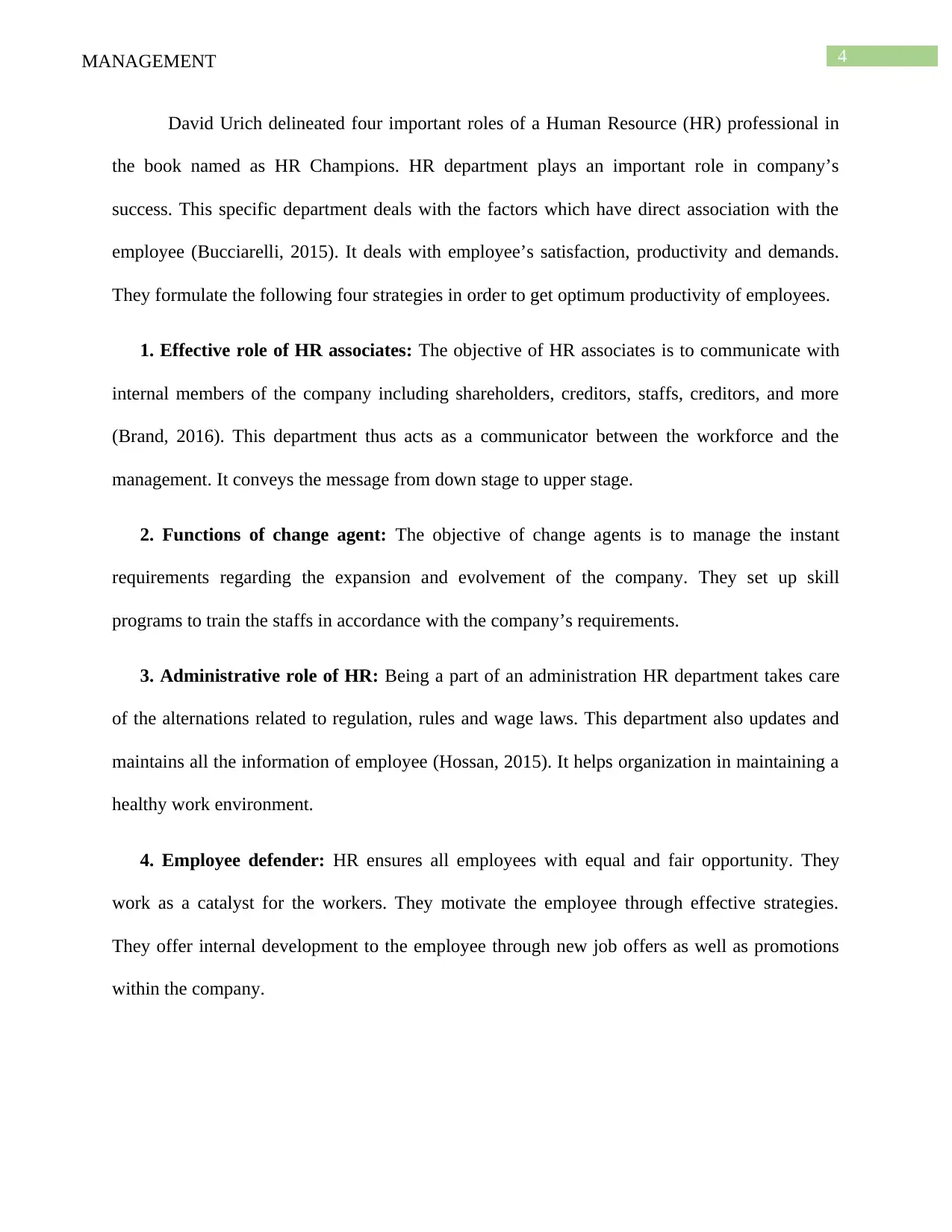
4MANAGEMENT
David Urich delineated four important roles of a Human Resource (HR) professional in
the book named as HR Champions. HR department plays an important role in company’s
success. This specific department deals with the factors which have direct association with the
employee (Bucciarelli, 2015). It deals with employee’s satisfaction, productivity and demands.
They formulate the following four strategies in order to get optimum productivity of employees.
1. Effective role of HR associates: The objective of HR associates is to communicate with
internal members of the company including shareholders, creditors, staffs, creditors, and more
(Brand, 2016). This department thus acts as a communicator between the workforce and the
management. It conveys the message from down stage to upper stage.
2. Functions of change agent: The objective of change agents is to manage the instant
requirements regarding the expansion and evolvement of the company. They set up skill
programs to train the staffs in accordance with the company’s requirements.
3. Administrative role of HR: Being a part of an administration HR department takes care
of the alternations related to regulation, rules and wage laws. This department also updates and
maintains all the information of employee (Hossan, 2015). It helps organization in maintaining a
healthy work environment.
4. Employee defender: HR ensures all employees with equal and fair opportunity. They
work as a catalyst for the workers. They motivate the employee through effective strategies.
They offer internal development to the employee through new job offers as well as promotions
within the company.
David Urich delineated four important roles of a Human Resource (HR) professional in
the book named as HR Champions. HR department plays an important role in company’s
success. This specific department deals with the factors which have direct association with the
employee (Bucciarelli, 2015). It deals with employee’s satisfaction, productivity and demands.
They formulate the following four strategies in order to get optimum productivity of employees.
1. Effective role of HR associates: The objective of HR associates is to communicate with
internal members of the company including shareholders, creditors, staffs, creditors, and more
(Brand, 2016). This department thus acts as a communicator between the workforce and the
management. It conveys the message from down stage to upper stage.
2. Functions of change agent: The objective of change agents is to manage the instant
requirements regarding the expansion and evolvement of the company. They set up skill
programs to train the staffs in accordance with the company’s requirements.
3. Administrative role of HR: Being a part of an administration HR department takes care
of the alternations related to regulation, rules and wage laws. This department also updates and
maintains all the information of employee (Hossan, 2015). It helps organization in maintaining a
healthy work environment.
4. Employee defender: HR ensures all employees with equal and fair opportunity. They
work as a catalyst for the workers. They motivate the employee through effective strategies.
They offer internal development to the employee through new job offers as well as promotions
within the company.
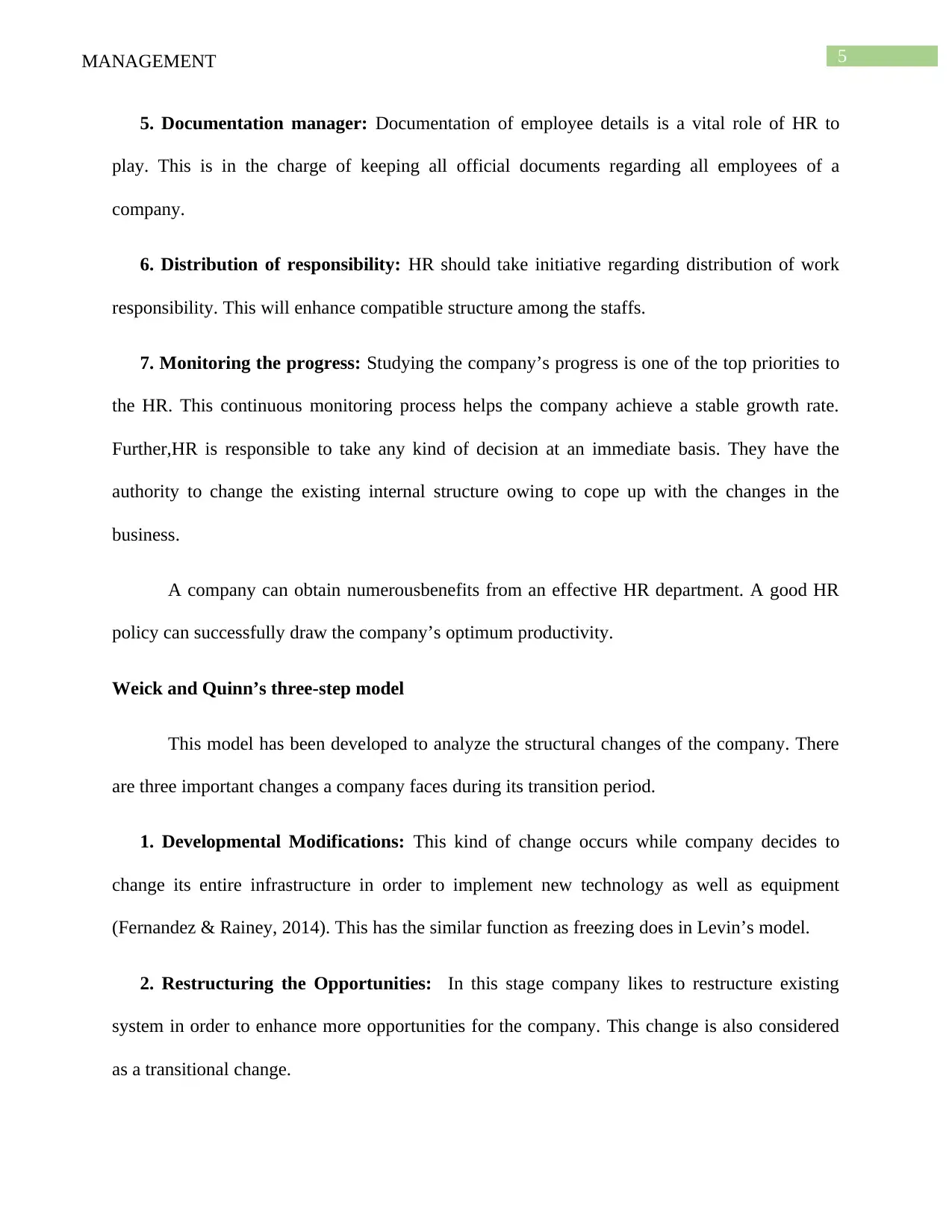
5MANAGEMENT
5. Documentation manager: Documentation of employee details is a vital role of HR to
play. This is in the charge of keeping all official documents regarding all employees of a
company.
6. Distribution of responsibility: HR should take initiative regarding distribution of work
responsibility. This will enhance compatible structure among the staffs.
7. Monitoring the progress: Studying the company’s progress is one of the top priorities to
the HR. This continuous monitoring process helps the company achieve a stable growth rate.
Further,HR is responsible to take any kind of decision at an immediate basis. They have the
authority to change the existing internal structure owing to cope up with the changes in the
business.
A company can obtain numerousbenefits from an effective HR department. A good HR
policy can successfully draw the company’s optimum productivity.
Weick and Quinn’s three-step model
This model has been developed to analyze the structural changes of the company. There
are three important changes a company faces during its transition period.
1. Developmental Modifications: This kind of change occurs while company decides to
change its entire infrastructure in order to implement new technology as well as equipment
(Fernandez & Rainey, 2014). This has the similar function as freezing does in Levin’s model.
2. Restructuring the Opportunities: In this stage company likes to restructure existing
system in order to enhance more opportunities for the company. This change is also considered
as a transitional change.
5. Documentation manager: Documentation of employee details is a vital role of HR to
play. This is in the charge of keeping all official documents regarding all employees of a
company.
6. Distribution of responsibility: HR should take initiative regarding distribution of work
responsibility. This will enhance compatible structure among the staffs.
7. Monitoring the progress: Studying the company’s progress is one of the top priorities to
the HR. This continuous monitoring process helps the company achieve a stable growth rate.
Further,HR is responsible to take any kind of decision at an immediate basis. They have the
authority to change the existing internal structure owing to cope up with the changes in the
business.
A company can obtain numerousbenefits from an effective HR department. A good HR
policy can successfully draw the company’s optimum productivity.
Weick and Quinn’s three-step model
This model has been developed to analyze the structural changes of the company. There
are three important changes a company faces during its transition period.
1. Developmental Modifications: This kind of change occurs while company decides to
change its entire infrastructure in order to implement new technology as well as equipment
(Fernandez & Rainey, 2014). This has the similar function as freezing does in Levin’s model.
2. Restructuring the Opportunities: In this stage company likes to restructure existing
system in order to enhance more opportunities for the company. This change is also considered
as a transitional change.
⊘ This is a preview!⊘
Do you want full access?
Subscribe today to unlock all pages.

Trusted by 1+ million students worldwide
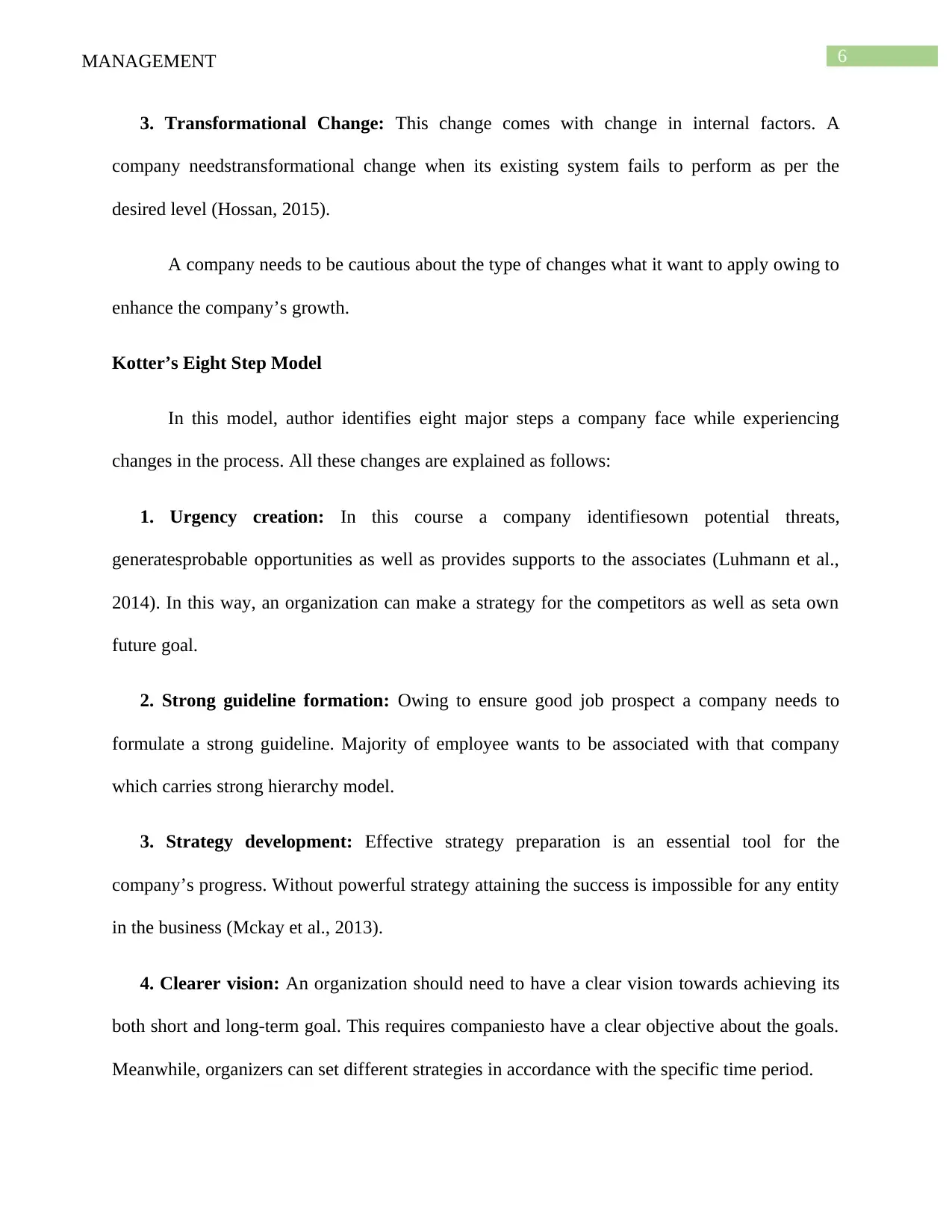
6MANAGEMENT
3. Transformational Change: This change comes with change in internal factors. A
company needstransformational change when its existing system fails to perform as per the
desired level (Hossan, 2015).
A company needs to be cautious about the type of changes what it want to apply owing to
enhance the company’s growth.
Kotter’s Eight Step Model
In this model, author identifies eight major steps a company face while experiencing
changes in the process. All these changes are explained as follows:
1. Urgency creation: In this course a company identifiesown potential threats,
generatesprobable opportunities as well as provides supports to the associates (Luhmann et al.,
2014). In this way, an organization can make a strategy for the competitors as well as seta own
future goal.
2. Strong guideline formation: Owing to ensure good job prospect a company needs to
formulate a strong guideline. Majority of employee wants to be associated with that company
which carries strong hierarchy model.
3. Strategy development: Effective strategy preparation is an essential tool for the
company’s progress. Without powerful strategy attaining the success is impossible for any entity
in the business (Mckay et al., 2013).
4. Clearer vision: An organization should need to have a clear vision towards achieving its
both short and long-term goal. This requires companiesto have a clear objective about the goals.
Meanwhile, organizers can set different strategies in accordance with the specific time period.
3. Transformational Change: This change comes with change in internal factors. A
company needstransformational change when its existing system fails to perform as per the
desired level (Hossan, 2015).
A company needs to be cautious about the type of changes what it want to apply owing to
enhance the company’s growth.
Kotter’s Eight Step Model
In this model, author identifies eight major steps a company face while experiencing
changes in the process. All these changes are explained as follows:
1. Urgency creation: In this course a company identifiesown potential threats,
generatesprobable opportunities as well as provides supports to the associates (Luhmann et al.,
2014). In this way, an organization can make a strategy for the competitors as well as seta own
future goal.
2. Strong guideline formation: Owing to ensure good job prospect a company needs to
formulate a strong guideline. Majority of employee wants to be associated with that company
which carries strong hierarchy model.
3. Strategy development: Effective strategy preparation is an essential tool for the
company’s progress. Without powerful strategy attaining the success is impossible for any entity
in the business (Mckay et al., 2013).
4. Clearer vision: An organization should need to have a clear vision towards achieving its
both short and long-term goal. This requires companiesto have a clear objective about the goals.
Meanwhile, organizers can set different strategies in accordance with the specific time period.
Paraphrase This Document
Need a fresh take? Get an instant paraphrase of this document with our AI Paraphraser
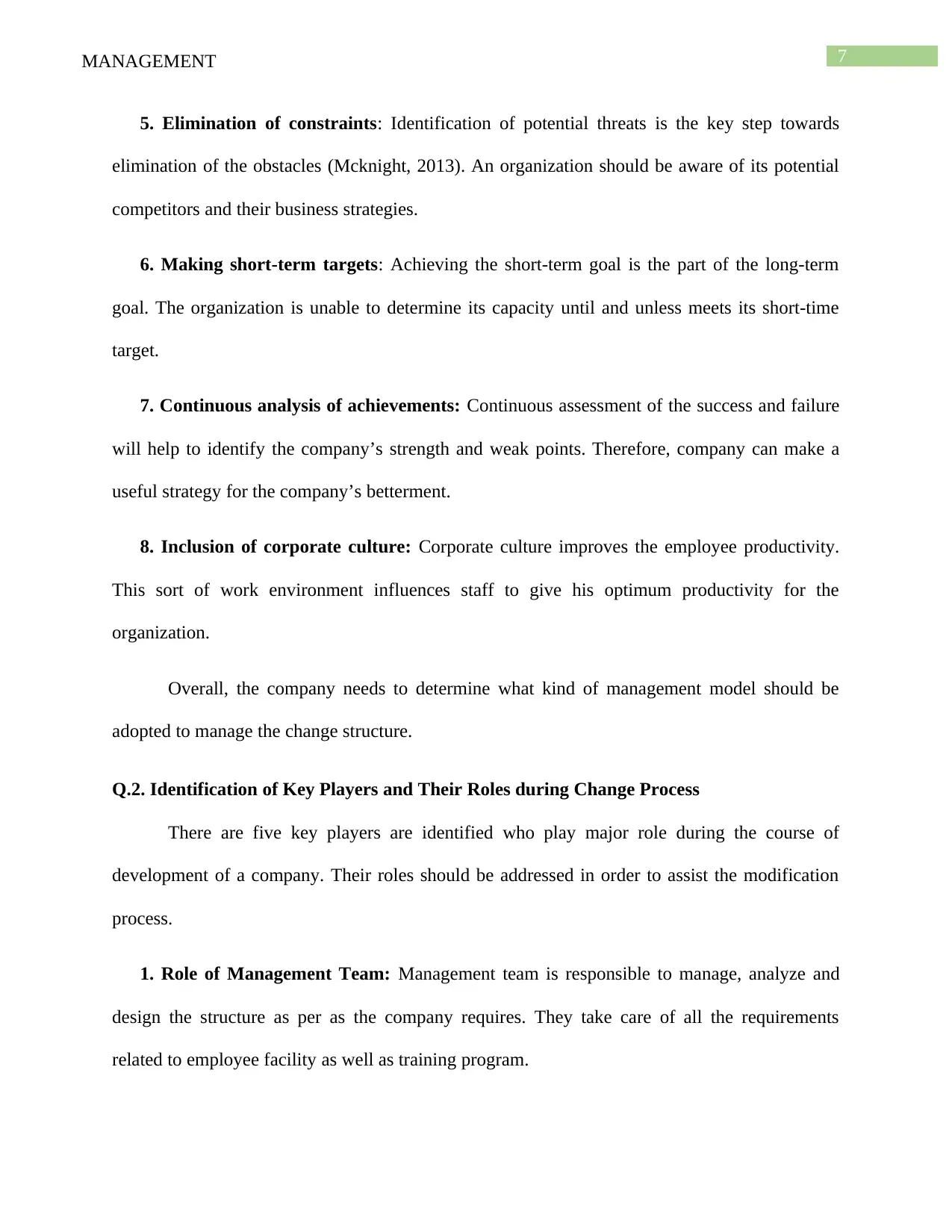
7MANAGEMENT
5. Elimination of constraints: Identification of potential threats is the key step towards
elimination of the obstacles (Mcknight, 2013). An organization should be aware of its potential
competitors and their business strategies.
6. Making short-term targets: Achieving the short-term goal is the part of the long-term
goal. The organization is unable to determine its capacity until and unless meets its short-time
target.
7. Continuous analysis of achievements: Continuous assessment of the success and failure
will help to identify the company’s strength and weak points. Therefore, company can make a
useful strategy for the company’s betterment.
8. Inclusion of corporate culture: Corporate culture improves the employee productivity.
This sort of work environment influences staff to give his optimum productivity for the
organization.
Overall, the company needs to determine what kind of management model should be
adopted to manage the change structure.
Q.2. Identification of Key Players and Their Roles during Change Process
There are five key players are identified who play major role during the course of
development of a company. Their roles should be addressed in order to assist the modification
process.
1. Role of Management Team: Management team is responsible to manage, analyze and
design the structure as per as the company requires. They take care of all the requirements
related to employee facility as well as training program.
5. Elimination of constraints: Identification of potential threats is the key step towards
elimination of the obstacles (Mcknight, 2013). An organization should be aware of its potential
competitors and their business strategies.
6. Making short-term targets: Achieving the short-term goal is the part of the long-term
goal. The organization is unable to determine its capacity until and unless meets its short-time
target.
7. Continuous analysis of achievements: Continuous assessment of the success and failure
will help to identify the company’s strength and weak points. Therefore, company can make a
useful strategy for the company’s betterment.
8. Inclusion of corporate culture: Corporate culture improves the employee productivity.
This sort of work environment influences staff to give his optimum productivity for the
organization.
Overall, the company needs to determine what kind of management model should be
adopted to manage the change structure.
Q.2. Identification of Key Players and Their Roles during Change Process
There are five key players are identified who play major role during the course of
development of a company. Their roles should be addressed in order to assist the modification
process.
1. Role of Management Team: Management team is responsible to manage, analyze and
design the structure as per as the company requires. They take care of all the requirements
related to employee facility as well as training program.
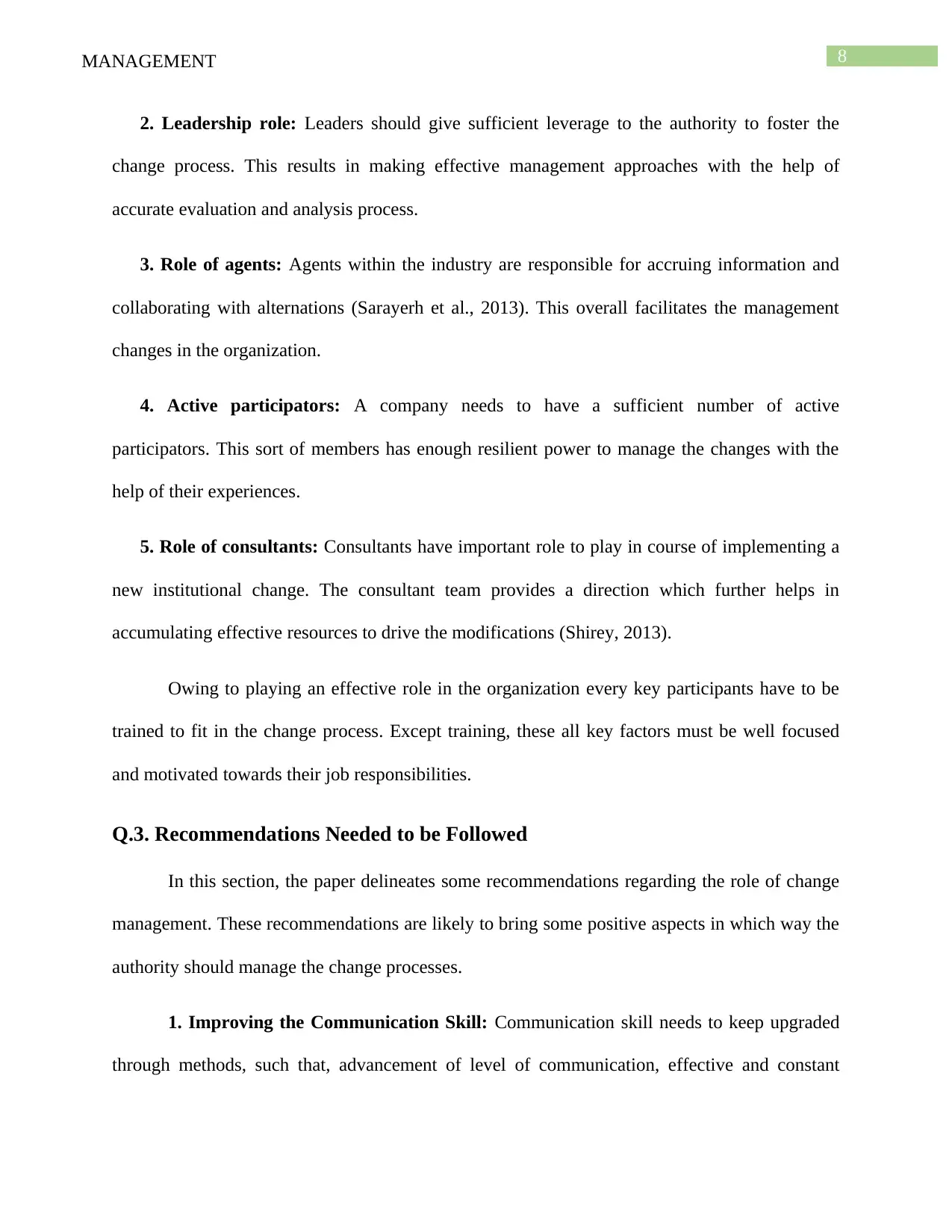
8MANAGEMENT
2. Leadership role: Leaders should give sufficient leverage to the authority to foster the
change process. This results in making effective management approaches with the help of
accurate evaluation and analysis process.
3. Role of agents: Agents within the industry are responsible for accruing information and
collaborating with alternations (Sarayerh et al., 2013). This overall facilitates the management
changes in the organization.
4. Active participators: A company needs to have a sufficient number of active
participators. This sort of members has enough resilient power to manage the changes with the
help of their experiences.
5. Role of consultants: Consultants have important role to play in course of implementing a
new institutional change. The consultant team provides a direction which further helps in
accumulating effective resources to drive the modifications (Shirey, 2013).
Owing to playing an effective role in the organization every key participants have to be
trained to fit in the change process. Except training, these all key factors must be well focused
and motivated towards their job responsibilities.
Q.3. Recommendations Needed to be Followed
In this section, the paper delineates some recommendations regarding the role of change
management. These recommendations are likely to bring some positive aspects in which way the
authority should manage the change processes.
1. Improving the Communication Skill: Communication skill needs to keep upgraded
through methods, such that, advancement of level of communication, effective and constant
2. Leadership role: Leaders should give sufficient leverage to the authority to foster the
change process. This results in making effective management approaches with the help of
accurate evaluation and analysis process.
3. Role of agents: Agents within the industry are responsible for accruing information and
collaborating with alternations (Sarayerh et al., 2013). This overall facilitates the management
changes in the organization.
4. Active participators: A company needs to have a sufficient number of active
participators. This sort of members has enough resilient power to manage the changes with the
help of their experiences.
5. Role of consultants: Consultants have important role to play in course of implementing a
new institutional change. The consultant team provides a direction which further helps in
accumulating effective resources to drive the modifications (Shirey, 2013).
Owing to playing an effective role in the organization every key participants have to be
trained to fit in the change process. Except training, these all key factors must be well focused
and motivated towards their job responsibilities.
Q.3. Recommendations Needed to be Followed
In this section, the paper delineates some recommendations regarding the role of change
management. These recommendations are likely to bring some positive aspects in which way the
authority should manage the change processes.
1. Improving the Communication Skill: Communication skill needs to keep upgraded
through methods, such that, advancement of level of communication, effective and constant
⊘ This is a preview!⊘
Do you want full access?
Subscribe today to unlock all pages.

Trusted by 1+ million students worldwide
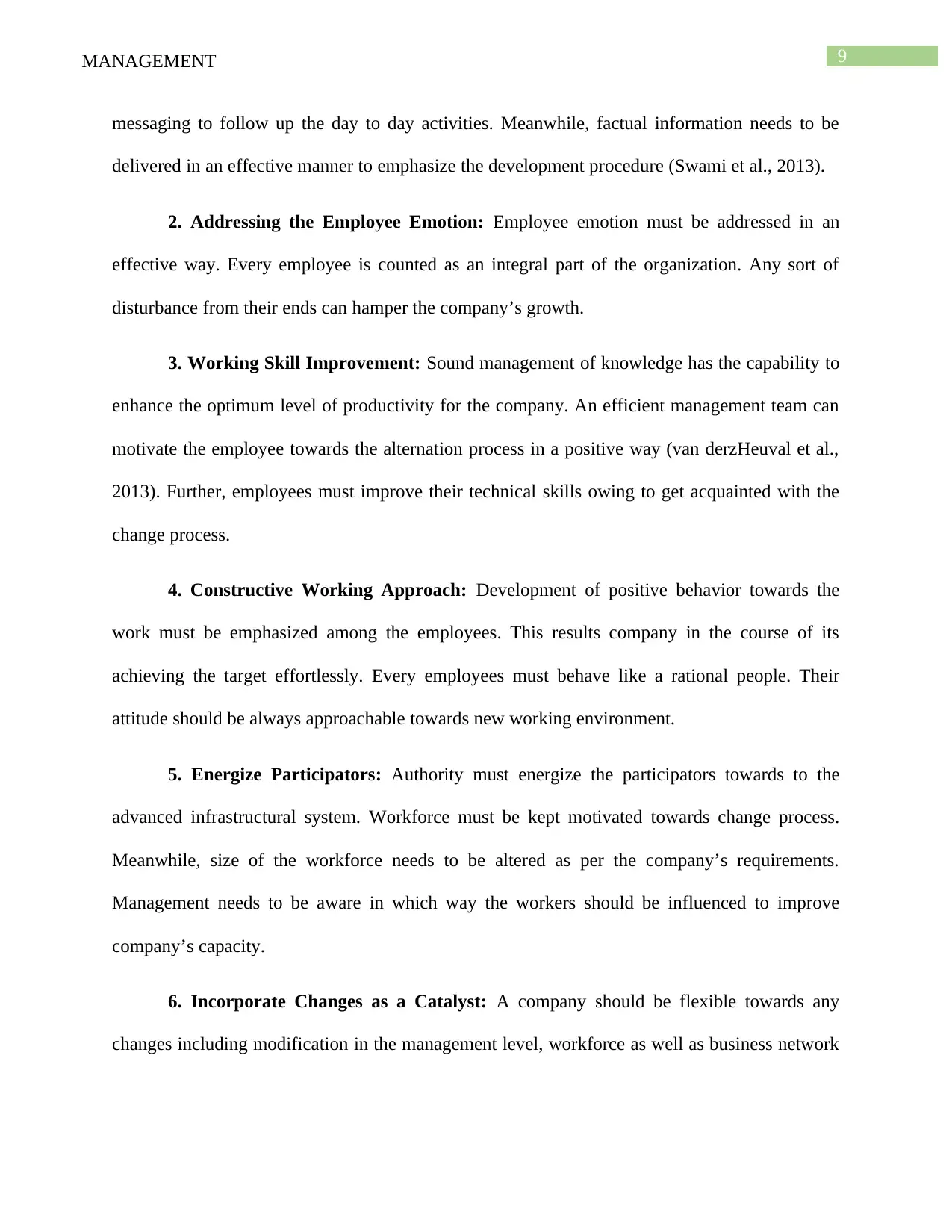
9MANAGEMENT
messaging to follow up the day to day activities. Meanwhile, factual information needs to be
delivered in an effective manner to emphasize the development procedure (Swami et al., 2013).
2. Addressing the Employee Emotion: Employee emotion must be addressed in an
effective way. Every employee is counted as an integral part of the organization. Any sort of
disturbance from their ends can hamper the company’s growth.
3. Working Skill Improvement: Sound management of knowledge has the capability to
enhance the optimum level of productivity for the company. An efficient management team can
motivate the employee towards the alternation process in a positive way (van derzHeuval et al.,
2013). Further, employees must improve their technical skills owing to get acquainted with the
change process.
4. Constructive Working Approach: Development of positive behavior towards the
work must be emphasized among the employees. This results company in the course of its
achieving the target effortlessly. Every employees must behave like a rational people. Their
attitude should be always approachable towards new working environment.
5. Energize Participators: Authority must energize the participators towards to the
advanced infrastructural system. Workforce must be kept motivated towards change process.
Meanwhile, size of the workforce needs to be altered as per the company’s requirements.
Management needs to be aware in which way the workers should be influenced to improve
company’s capacity.
6. Incorporate Changes as a Catalyst: A company should be flexible towards any
changes including modification in the management level, workforce as well as business network
messaging to follow up the day to day activities. Meanwhile, factual information needs to be
delivered in an effective manner to emphasize the development procedure (Swami et al., 2013).
2. Addressing the Employee Emotion: Employee emotion must be addressed in an
effective way. Every employee is counted as an integral part of the organization. Any sort of
disturbance from their ends can hamper the company’s growth.
3. Working Skill Improvement: Sound management of knowledge has the capability to
enhance the optimum level of productivity for the company. An efficient management team can
motivate the employee towards the alternation process in a positive way (van derzHeuval et al.,
2013). Further, employees must improve their technical skills owing to get acquainted with the
change process.
4. Constructive Working Approach: Development of positive behavior towards the
work must be emphasized among the employees. This results company in the course of its
achieving the target effortlessly. Every employees must behave like a rational people. Their
attitude should be always approachable towards new working environment.
5. Energize Participators: Authority must energize the participators towards to the
advanced infrastructural system. Workforce must be kept motivated towards change process.
Meanwhile, size of the workforce needs to be altered as per the company’s requirements.
Management needs to be aware in which way the workers should be influenced to improve
company’s capacity.
6. Incorporate Changes as a Catalyst: A company should be flexible towards any
changes including modification in the management level, workforce as well as business network
Paraphrase This Document
Need a fresh take? Get an instant paraphrase of this document with our AI Paraphraser
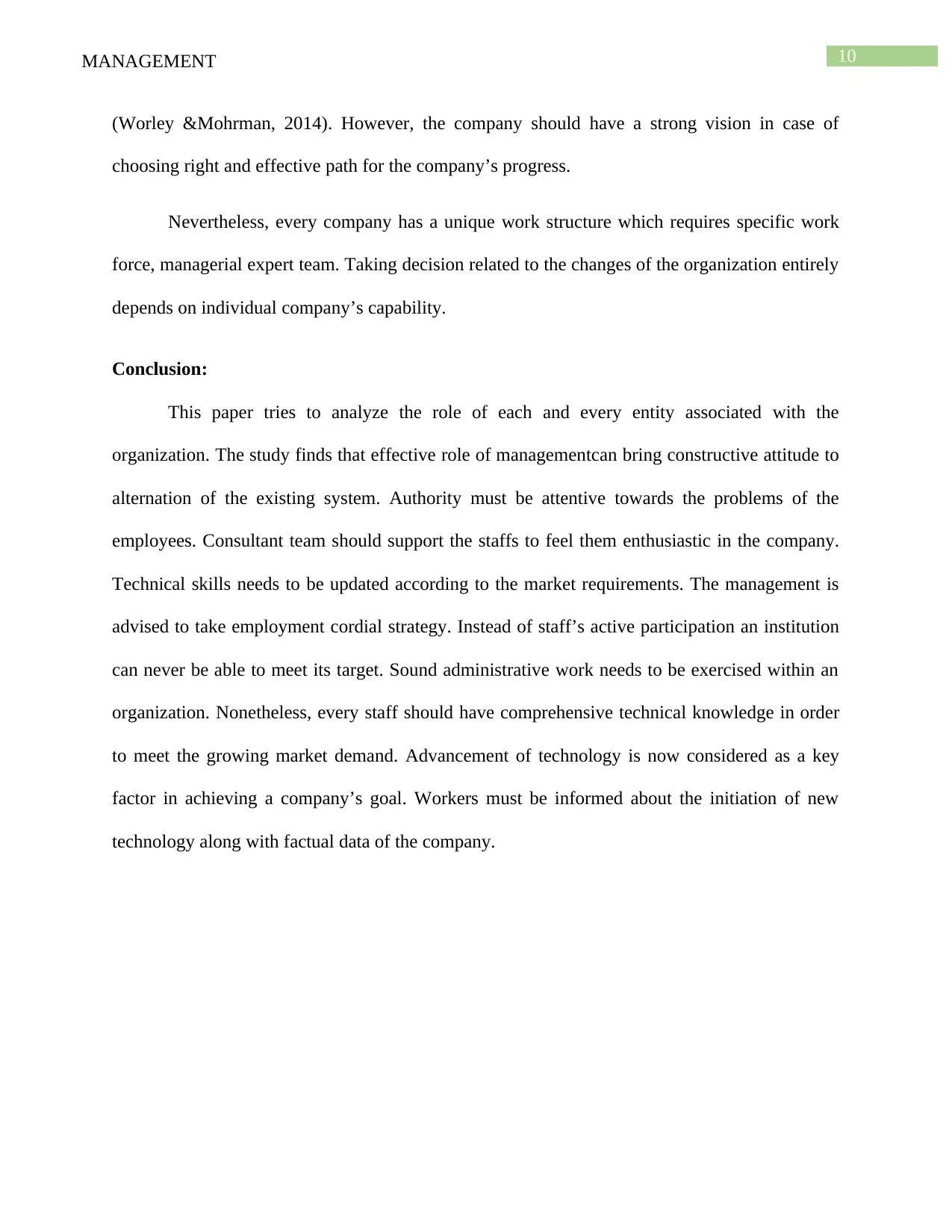
10MANAGEMENT
(Worley &Mohrman, 2014). However, the company should have a strong vision in case of
choosing right and effective path for the company’s progress.
Nevertheless, every company has a unique work structure which requires specific work
force, managerial expert team. Taking decision related to the changes of the organization entirely
depends on individual company’s capability.
Conclusion:
This paper tries to analyze the role of each and every entity associated with the
organization. The study finds that effective role of managementcan bring constructive attitude to
alternation of the existing system. Authority must be attentive towards the problems of the
employees. Consultant team should support the staffs to feel them enthusiastic in the company.
Technical skills needs to be updated according to the market requirements. The management is
advised to take employment cordial strategy. Instead of staff’s active participation an institution
can never be able to meet its target. Sound administrative work needs to be exercised within an
organization. Nonetheless, every staff should have comprehensive technical knowledge in order
to meet the growing market demand. Advancement of technology is now considered as a key
factor in achieving a company’s goal. Workers must be informed about the initiation of new
technology along with factual data of the company.
(Worley &Mohrman, 2014). However, the company should have a strong vision in case of
choosing right and effective path for the company’s progress.
Nevertheless, every company has a unique work structure which requires specific work
force, managerial expert team. Taking decision related to the changes of the organization entirely
depends on individual company’s capability.
Conclusion:
This paper tries to analyze the role of each and every entity associated with the
organization. The study finds that effective role of managementcan bring constructive attitude to
alternation of the existing system. Authority must be attentive towards the problems of the
employees. Consultant team should support the staffs to feel them enthusiastic in the company.
Technical skills needs to be updated according to the market requirements. The management is
advised to take employment cordial strategy. Instead of staff’s active participation an institution
can never be able to meet its target. Sound administrative work needs to be exercised within an
organization. Nonetheless, every staff should have comprehensive technical knowledge in order
to meet the growing market demand. Advancement of technology is now considered as a key
factor in achieving a company’s goal. Workers must be informed about the initiation of new
technology along with factual data of the company.
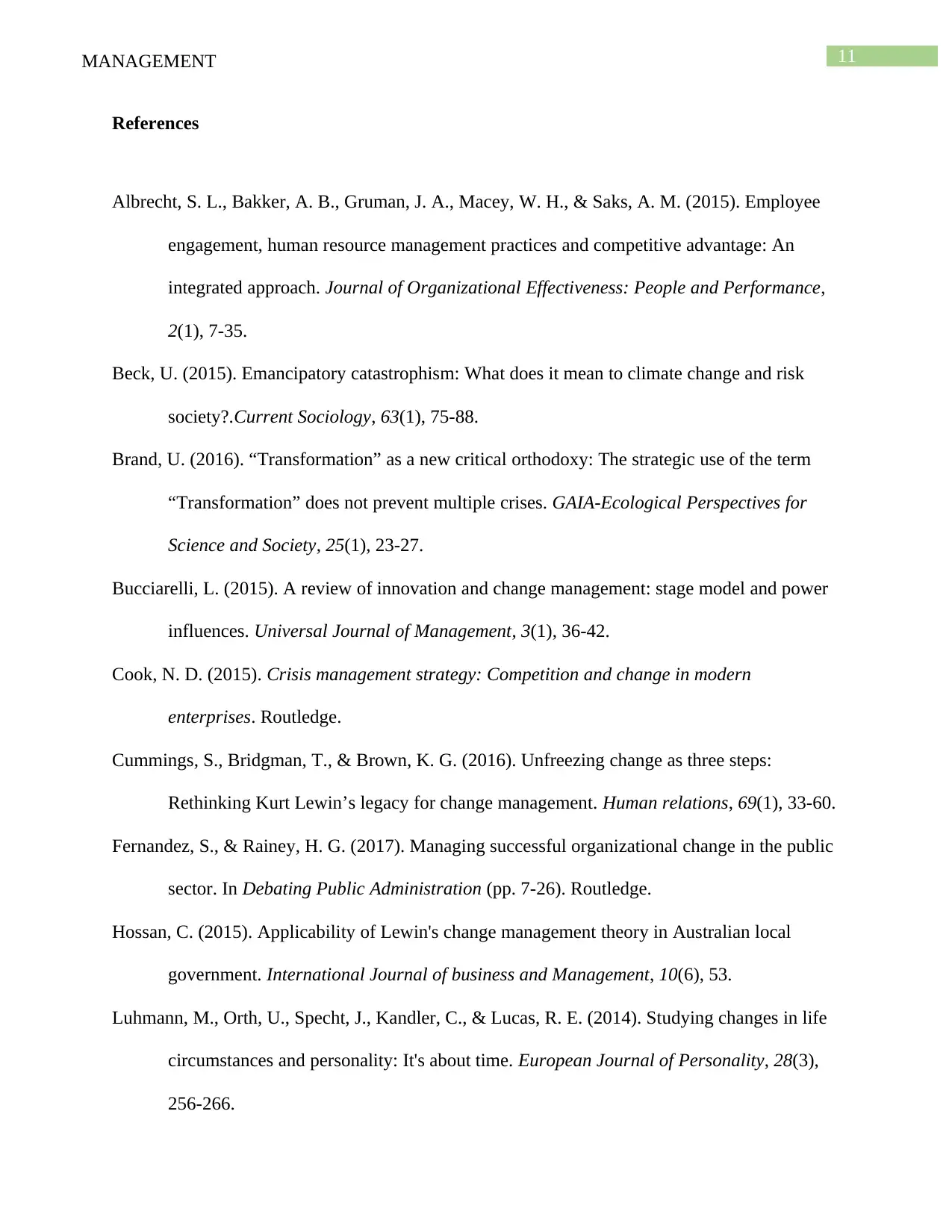
11MANAGEMENT
References
Albrecht, S. L., Bakker, A. B., Gruman, J. A., Macey, W. H., & Saks, A. M. (2015). Employee
engagement, human resource management practices and competitive advantage: An
integrated approach. Journal of Organizational Effectiveness: People and Performance,
2(1), 7-35.
Beck, U. (2015). Emancipatory catastrophism: What does it mean to climate change and risk
society?.Current Sociology, 63(1), 75-88.
Brand, U. (2016). “Transformation” as a new critical orthodoxy: The strategic use of the term
“Transformation” does not prevent multiple crises. GAIA-Ecological Perspectives for
Science and Society, 25(1), 23-27.
Bucciarelli, L. (2015). A review of innovation and change management: stage model and power
influences. Universal Journal of Management, 3(1), 36-42.
Cook, N. D. (2015). Crisis management strategy: Competition and change in modern
enterprises. Routledge.
Cummings, S., Bridgman, T., & Brown, K. G. (2016). Unfreezing change as three steps:
Rethinking Kurt Lewin’s legacy for change management. Human relations, 69(1), 33-60.
Fernandez, S., & Rainey, H. G. (2017). Managing successful organizational change in the public
sector. In Debating Public Administration (pp. 7-26). Routledge.
Hossan, C. (2015). Applicability of Lewin's change management theory in Australian local
government. International Journal of business and Management, 10(6), 53.
Luhmann, M., Orth, U., Specht, J., Kandler, C., & Lucas, R. E. (2014). Studying changes in life
circumstances and personality: It's about time. European Journal of Personality, 28(3),
256-266.
References
Albrecht, S. L., Bakker, A. B., Gruman, J. A., Macey, W. H., & Saks, A. M. (2015). Employee
engagement, human resource management practices and competitive advantage: An
integrated approach. Journal of Organizational Effectiveness: People and Performance,
2(1), 7-35.
Beck, U. (2015). Emancipatory catastrophism: What does it mean to climate change and risk
society?.Current Sociology, 63(1), 75-88.
Brand, U. (2016). “Transformation” as a new critical orthodoxy: The strategic use of the term
“Transformation” does not prevent multiple crises. GAIA-Ecological Perspectives for
Science and Society, 25(1), 23-27.
Bucciarelli, L. (2015). A review of innovation and change management: stage model and power
influences. Universal Journal of Management, 3(1), 36-42.
Cook, N. D. (2015). Crisis management strategy: Competition and change in modern
enterprises. Routledge.
Cummings, S., Bridgman, T., & Brown, K. G. (2016). Unfreezing change as three steps:
Rethinking Kurt Lewin’s legacy for change management. Human relations, 69(1), 33-60.
Fernandez, S., & Rainey, H. G. (2017). Managing successful organizational change in the public
sector. In Debating Public Administration (pp. 7-26). Routledge.
Hossan, C. (2015). Applicability of Lewin's change management theory in Australian local
government. International Journal of business and Management, 10(6), 53.
Luhmann, M., Orth, U., Specht, J., Kandler, C., & Lucas, R. E. (2014). Studying changes in life
circumstances and personality: It's about time. European Journal of Personality, 28(3),
256-266.
⊘ This is a preview!⊘
Do you want full access?
Subscribe today to unlock all pages.

Trusted by 1+ million students worldwide
1 out of 14
Related Documents
Your All-in-One AI-Powered Toolkit for Academic Success.
+13062052269
info@desklib.com
Available 24*7 on WhatsApp / Email
![[object Object]](/_next/static/media/star-bottom.7253800d.svg)
Unlock your academic potential
Copyright © 2020–2025 A2Z Services. All Rights Reserved. Developed and managed by ZUCOL.





